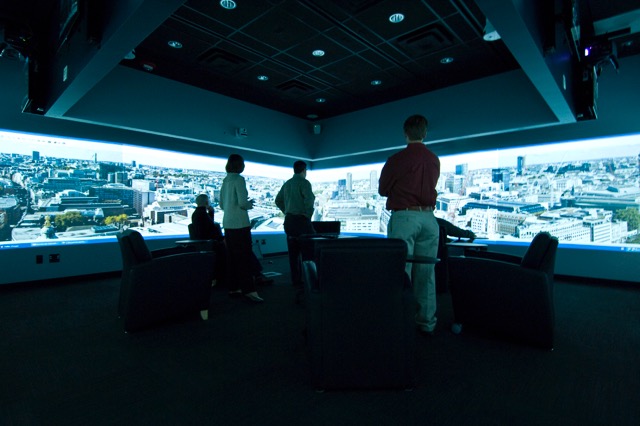
CHAPEL HILL, NC – Big data and data presented as imagery hold great value as tools for educators and researchers, but working with enormous data sets can be overwhelming.
Medical records, social networking data, environmental measurements gleaned from remote sensors, online transactions, and more can help doctors diagnose their patients, allow businesses to better serve their customers, and help scientists understand everything from how cancers spread to the impact of climate change on ecosystems.
Yes, the data is available, but the people who need to use it struggle to examine it in ways that are intuitive and allow for group collaboration.
Researchers at the Renaissance Computing Institute, a UNC-Chapel Hill institute, addressed this problem by developing the Social Computing Room (SCR), a custom-designed environment that uses 12 projectors to display information on all four walls of a square room, creating an image-immersive environment. The SCR’s 360-degree display can be adapted to a wide range of purposes, and students, faculty and researchers are encouraged to unleash their imaginations when using the room.
Since the first SCR was installed in UNC-Chapel Hill’s Information Technology Services Building on Manning Drive (ITS Manning) in 2007, SCRs have been used to examine large numbers of complex medical images, such as melanoma biopsy slides, and examine ancient artifacts too fragile to be touched. Students have used the rooms to display digital posters and present digital artwork and performances in lieu of more typical final projects. The spaces have also been used as presentation venues for artwork and a law school mock trial.
Three SCRs now exist at Triangle area universities, including the room at ITS Manning, a room at the Odum Institute for Research in Social Science in UNC’s Davis Library, and a room at NC State University’s D. H. Hill Library called the Visualization Studio.
Each room holds up to 15 people comfortably and includes three projectors (12 per wall) to create a continuous, floor-to-ceiling display. A simple Windows computer controls the displays and users can access standard software, such as web browsers and PowerPoint, or load their own software. In addition, every SCR includes built in cameras, speakers, microphones, and an echo-cancelling audio system to support high-quality, immersive presentations and video and audio conferencing.
The rooms—all available for use free of charge—have been popular and RENCI has documented the development of the SCRs and some of their uses in a white paper entitled Getting to Know the Social Computing Rooms.
To learn more about SCRs and how faculty and students are using them, read the white paper here.


